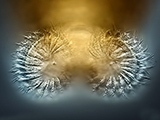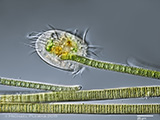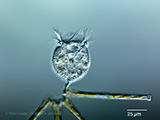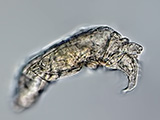|
After a two-year COVID break, a microscopy workshop was held again at the "Wildnisschule Teerofenbrücke" at the end of May. As in the years before, a focus was on the study of on the "aufwuchs" on slides that had been exposed a few days earlier in various places on the side arms of the Oder. A heartily "Thank you" to R. and U. Szewzyk for preparing and organizing this workshop!.
The focus of my own observations was the study of (dry) mosses and ephemeral waters for rotifers. Some previously never seen morphotypes were discovered, such as a not yet described form of Adineta, as well as the species Philodina duplicalcar and Macrotrachela aculeata. A list of all species documented on this site can be found here >> . |
 |
|
|
|
|
| Planktonkurs Heiliges Meer 2021 |
|
Because of Covid the annual workshop at the nature reserve "Heiliges Meer "on limnic plankton took place in November. This gave the chance to study the plankton in a different season of the year. But there are also other protected habitats which are a rich source for rare microscopic critters. Interesting observations were: an unknown type of ectoparasites on Filinia longiseta, the rare Mytilina trigona, a strange behavior of Stentor multiformis, Vasicola ciliata, and other rare ciliates. |
|
|
|
|
|
 |
|
|
| Some rotifers from Norway |
|
|
| Some microinvertebrates from the Simplon area |
|
|
 |
Some microinvertebrates from Northern Italy |
|
|
|
During a stay at the IRSA in Verbania-Pallanza I had the chance to visit several locations to look for rotifers. Among others the rotifer Enteroplea lacustris, Lecane elsa and some unknown bdelloid rotifers were found. More on this here >>> |
|
|
|
|
|
 |
|
|
|
|
|
 |
Some microscopic organisms of lotic waters (II) 08/2021 |
|
|
|
During a holiday in Brittany some lotic waters were observed in the Northern Brittany area. Some finds included some Embata-species; also for the first time I could observe the bdelloid rotifer Henoceros falcatus. Back home this rotifer could also be found in the Ruhr-district of Germany. |
|
|
|
|
|
 |
|
|
 |
NABU EN-Kreis; Vortrag über Rädertiere |
|
|
|
Für den 7.7. hatte der NABU Ennepe-Ruhr-Kreis einen Online-Vortrag zum Thema "Rädertiere" organisiert. Hier steht der Vortrag als pdf zum Download zur Verfügung |
|
|
|
|
|
 |
|
|
 |
Adineta from 24000 year old permafrost (06/2021) |
|
|
|
Bdelloid rotifers are survival artists, not only concerning desiccation, but they can also survive lowest temperatures for example in liquid nitrogen. Now some researchers have found the bdelloid rotifer Adineta sp. in a drill core from Siberian permafrost, which has been shown to be 24000 years old. The recovered specimens were kept in culture, from which I had the chance to take some images whiche are presented here >>>> |
|
|
|
|
|
 |
|
|
 |
Some microscopic organisms from lotic waters (I) (05/2021) |
|
|
|
During the first half of 2021 several creeklets and small rivers in the Ruhr-district of Germany were examined for microscopic organisms. Some protists that had not been found in bogs/ ponds or lakes could be photographed, for example: Ophryoglena flava, Pseudomonolicaryon sp. or other spathiid ciliates. The same is true for some monogonont rotifer species like Proales theodora, Encentrum spinosum, Cephalodella exigua, which all seem to be able to feed on diatoms. Also Philodina flaviceps, which seems to be at home in all creeklets that were observed could be found with ingested diatoms. Another bdelloid rotifer was found in a near-by creeklet which has some unusual traits and seems to be a new species. |
|
|
|
|
|
 |
|
|
 |
Rotifers from birdbaths and lithotelmata (11/2020) |
|
|
|
Bdelloid rotifers are world champions when it comes to survive desiccation. This can be demonstrated even at home if there is a garden with a bowl of water which may serve as birdbath in summer. There are some typical rotifers that can be observed in such birdbaths. Also the granite rocks of the coastal landscape of Brittany/ Francey have dents that can fill with water. (Lithotelmata). In these ephemeral puddles some special rotifers were found, whose characteristic combinatios of traits does not correspond to those of the taxa described in the literature so far. More on this here >>> |
|
|
|
|
|
 |
|
|
 |
Division of the ciliate Stentor roeselii (11/2020) |
|
|
|
For the second time the division of the ciliate Stentor roeselii could be observed. More on this here >>> |
|
|
|
|
|
 |
|
|
 |
Frontal aspects of bdelloid rotifers (09/2020) |
|
|
|
It is of course a trivial thing to point out that the name of the "wheel animalcules" is derived from the "wheel-like" appearance of their front part. Although I have been dealing with this creatures for quite some time now, there are still certain phenomena that are fascinating for me, and there are also some phenomena which I still don't really understand. More on this here >>> |
|
|
|
|
|
 |
|
|
 |
Enigmatic Neuston (05/2020) |
|
|
|
|
 |
The males of monogonont rotifers (05/2020) |
|
|
|
|
 |
some observations on rotifer resting eggs (04/2020) |
|
|
|
Females of monogonont rotifers produce three different sorts of eggs: (1) diploid amictic eggs from which amictic females hatch, (2) haploid mictic eggs which develop into males if not fertilized, and (3) haploid mictic eggs that develop into diploid resting eggs if fertilized. The resting eggs of monogonont rotifers may be looked upon not as eggs but as multinucleate embryos that are in a resting state while enclosed in a shell. In several species the nuclei of the embryo could be observed: Asplanchna priodonta, Filinia longiseta and Rhinoglena frontalis |
|
|
|
|
|
 |
|
|
 |
marine critters from Bali (04/2020) |
|
|
|
|
In March 2020 I had the chance to visit Villa Markisa in Tulamben/ Bali / Indonesia, which is a fantastic resort for muck diving. Norris, my diveguide showed me a lot of critters I had never seen before. The main focus was on molluscs / nudibranchs, but there are other organisms as well. Here are some of them.... |
|
|
|
|
|
 |
|
|
|
 |
rotifers from Bali (04/2020) |
|
|
|
|
|
|
 |
Updated information for the rotifer Rhinoglena frontalis (04/2020) |
|
|
|
|
Although the monogonont rotifer Rhinoglena frontalis is a plankton species it seems to be very rare. Dr. Ole Riemann had the luck to find a pond with this species and allowed to present some of his fantastic images on this website. More on this here >>>> |
|
|
|
|
|
 |
|
|
|
 |
limnic plankton in springtime (03/2020) |
|
|
|
|
 |
Some new rotifers and updates (01/2020) |
|
|
|
|
|
|
 |
Rotifer images of Dr. Martin Kreutz (10/2019) |
|
|
|
Dr. Martin Kreutz, author of the outstanding book about protists and other microscopic organisms from the Simmelried in southern Germany has contributed some fantastic images about some rare rotifers from that location, for example Collotheca atrochoides and Collotheca libera. These photographs seem to be the only ones from these critters and are unique in the www. Other images show some interesting features of the retrocerebral organ of Cephalodella forficata.
|
|
|
|
|
|
 |
|
|
 |
Microscopic organisms from Brittany / France (08/ 2019) |
|
|
|
|
 |
New Adineta morphospecies (06/2019) |
|
|
|
Another meeting of the BMG took place at the biological station "Teerofenbrücke" in the nature reserve "NSG Unteres Odertal". Two weeks before the meeting microslides had been exposed at selected aquatic locations to allow the settlement of microscopic organisms on these slides. Also the plankton and periphytic organisms of the billabongs of the river Oder were observed. In the dry moss from a wall of a floodgate a new morphospecies of Adineta was found. |
|
|
|
|
|
 |
|
|
 |
Mesopsammon fauna (05/2019) |
|
|
|
|
Some members of the "Berliner Mikroskopische Gesellschaft" (BMG) had a meeting at the German coast of the Baltic Sea and -among other studies- examined the mesopsammon fauna of the beach of Priwall opposite of Travemünde. The organisms living between the sand grains are highly adapted to their environment. Some organisms that could be observed are: otoplanid flatworms, hairybacks like Turbanella sp. or Hetereoxenotrichula, but also ciliates like Trachelocerca cf sagitta. |
|
|
|
|
|
 |
|
|
|
 |
Planktonkurs NSG Heiliges Meer (04/2019) |
|
|
|
|
At the end of April, again the plankton course took place at the biological station of the nature reserve "NSG Heiliges Meer". Because of the variety of waters and wetlands in this nature reserve, this course is ideal for microscopists. In addition to the opportunity to observe the aquatic life using the available (or one's own) microscope, the course offers the opportunity, through the practical measurement of physical and chemical data in conjunction with lectures, to learn more about the interaction of abiotic and biotic factors in the ecosystem "lake". Some of the found species include among others: the protists: Vorticella chlorostigma, Gastronauta clatratus, Thuricola folliculata, Heliophrya rotunda, Clathrulina elegans; the rotifers Collotheca campanulata, Cephalodella physalis, Floscularia janus, and the algae: Botryococcus braunii, Gonyostomum semen, Mallomonas caudata and Synura uvella. |
|
|
|
|
|
 |
|
|
|
 |
Cephalodella stenroosi (03/2019) |
|
|
|
|
|
|
 |
Turaniella vitrea in a sapropelic creek bank in Hattingen/NRW (01.2019) |
|
|
|
|
|
|
 |
A new bdelloid rotifer from the "Arnsberger Wald" (12/2018) |
|
|
|
|
|
|
 |
A single worm infested by three parasite species (12/2018) |
|
|
|
|
|
|
 |
Microscopic Organisms from Hiddensee (11/2018) |
|
|
|
|
|
|
 |
Some Organisms from Sphagnum ponds in Griendtsveen / NL (11/2018) |
|
|
|
|
For the preparation of a meeting of the Naturwissenschaftliche Vereinigung Hagen, some samples were collected from Sphagnum ponds in Griendtsveen/ Netherlands. Some species found are: Collotheca coronetta coronetta, Keratella ticinensis, Lepadella minuta, Microcodides chlaena, Proales doliaris, Synura sphagnicola, and ciliates like Halteria grandinella, Holophrya sp., the hypotrich ciliate Urostyla grandis and its parasite, the suctorian Podophrya urostylae. |
|
|
|
|
|

|
|
|
|
 |
Updates |
|
|
|
|
|
|
 |
Updates |
|
|
|
|
|
|
 |
Limnic microscopic organisms from Brittany / France |
|
|
|
|
|
|
 |
Marine microscopic organisms from Brittany / France |
|
|
|
|
|
|
 |
Habrotrocha ligula from NSG Koffituten |
|
|
|
|
A bdelloid rotifer that looks like Habrotrocha ligula has been found in the nature reserve NSG Koffituten near Hopsten (Tecklenburger Land), but also shows some differences. |
|
|
|
|
|
 |
|
|
|
 |
Updates |
|
|
|
|
|
|
 |
Two rotifer species from treeholes |
|
|
|
|
|
|
 |
Rotifers in Frullania moss |
|
|
|
|
|
|
 |
Some plankton and other microscopic organisms from the nature reserve NSH Heiliges Meer |
|
|
|
|
The "plankton course" at the biological station of the NSG Heiliges Meer is always a rewarding event: Because of the variety of waters and wetlands in the NSG, this course is ideal for people who like to study the microscopical life of limnic waters. In addition to the opportunity to observe the aquatic life using the available (or one's own) microscopes, the course offers the opportunity to learn a great deal about the interaction of abiotic and biotic factors in the ecosystem "lake" through the practical measurement of physical and chemical data in conjunction with presentations. Besides diatoms and other algae like Synura spinosa some protists like Vorticella aquadulcis or Coleps hirtus and some rotifers like Collotheca trilobata, Kellicottia bostoniensis, Gastropus minor or Synchaeta with parasites could be found. |
|
|
|
|
|
 |
|
|
|
 |
Ceratotrocha cornigera |
|
|
|
|
This strange looking bdelloid rotifer has been found in Witten, Germany |
|
|
|
|
|
 |
|
|
|
 |
Some rotifers from Spitsbergen (Svalbard) |
|
|
|
|
|
|
 |
Some organisms from Bodman & Simmelried / Germany |
|
|
|
|
|
|
 |
Some new rotifers & additions |
|
|
|
|
|
| |
 |
Some organisms from a salt spring |
|
|
|
|
|
 |
Some new rotifers & additions |
|
|
|
|
|
|
 |
Some rotifers from the Phillipines (2016) |
|
|
|
|
Anilao in the Batangas area of Luzon/ Philippines is one of the most rewarding dive locations in the world for underwater macro photographers. But this is not all. A moss sample collected in Club Ocellaris revealed some interesting bdelloid rotifers, among others a new form of Adineta. |
|
|
|
|
|
 |
|
|
 |
Some monogonont rotifers (2016) |
|
|
|
|
|
|
 |
Updated (2016) |
|
|
|
|
|
|
 |
Abrochtha intermedia from an ephemeral puddle in Germany (2016) |
|
|
|
|
Abrochtha intermedia has been found in an ephemeral puddle in Hagen/ Germany. Although this species is supposed to be cosmopolitan this may be the first discovery of A. intermedia in Germany. |
|
|
|
|
|
 |
|
|
 |
Updated information for some rotifers, desmids and protists. (2016) |
|
|
|
|
|
|
 |
Updated information for some rotifers, desmids and protists. (2016) |
|
|
|
|
|
|
 |
Updated information for some rotifers and protists (2015) |
|
|
|
|
|
|
 |
Four new rotifers & some protist images added |
|
|
|
|
|
|
 |
Some Microinvertebrates from Svalbard (2015) |
|
|
|
|
|
|
|
 |
Some interesting species from the Simmelried near Konstanz, Germany (2015) |
|
|
|
|
|
|
 |
Two rotifers from Czech Republic (2015) |
|
|
|
|
|
|
 |
Notommata pachyura (2015) |
|
|
|
|
|
|
 |
On the feeding of Collotheca pelagica (2015) |
|
|
|
|
|
|
 |
Beauchampiella eudactylota |
|
|
|
|
|
|
 |
Tetrasiphon hydrocora (2015) |
|
|
|
|
|
|
 |
Kellicottia bostoniensis (2015) |
|
|
|
|
|
|
 |
Enteroplea lacustris (2015) |
|
|
|
|
|
|
 |
Wahner Heide/ Cologne/ Germany: a great place for rare critters (2015) |
|
|
|
|
Three years ago the rare rotifer Ptygura rotifer (Pseudoecistes rotifer) had been rediscovered in the Wahner Heide near Cologne. Now the newly described bdelloid rotifer Otostephanos jolantae has been found there. This is probably the first record for Germany. The monogonont Trichocerca cavia could be documented for this location as well. |
|
|
|
|
|
 |
|
|
|
 |
Macrotrachela zickendrahti (2015) |
|
|
|
|
Macrotrachela zickendrahti has been found in a nature reserve Oberrasen/ South Tirol. This rotifer looks pretty weird with its bizarre spines. |
|
|
|
|
|
 |
|
|
|
 |
New images for Macrotrachela habita |
|
|
|
|
Macrotrachela habita has been found in a moor-area near the Steinhuder Meer in Lower Saxony/ Germany (2014) |
|
|
|
|
|
 |
|
|
|
 |
Resticula plicata from Bavaria (2014) |
|
|
|
|
Resticula plicata has been found in the nature reserve Kendlmuehlfilze in Bavaria/ Germany |
|
|
|
|
|
 |
|
|
 |
Some algae images added (2014) |
|
|
|
|
Some new desmids and chlorophyte alge from the Alps and other locations have been added to this site, among others: Cosmarium holmiense, C. subundulatum, C. venustum, Cylindrocystis crassa, Desmidium grevillei, Hyalotheca mucosa, Euastrum ampullaceum, Euastrum crassum, Tetrallantois lagerheimi, Westella botryoides, Xanthidium bifidum. |
|
The eversion of the daughter coenobia of Volvox could be observed. |
|
|
|
 |
|
|
|
|
|
|
|
|
|
|